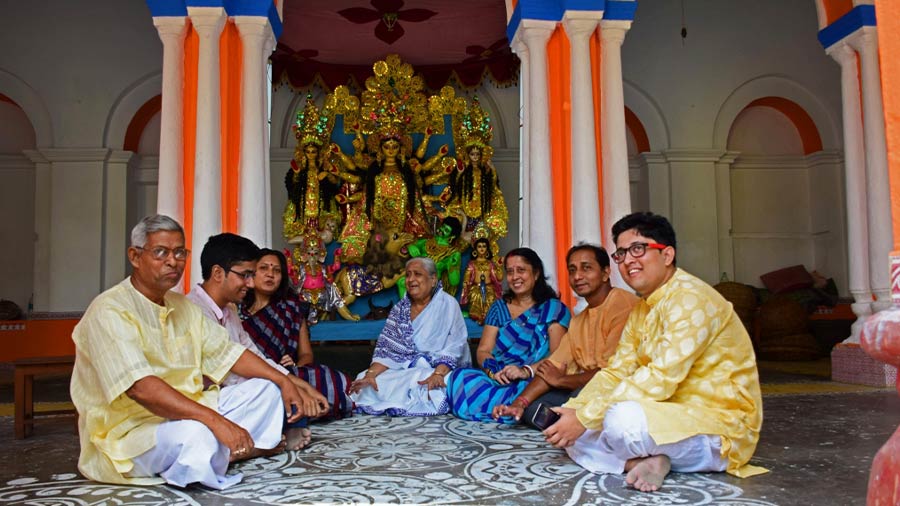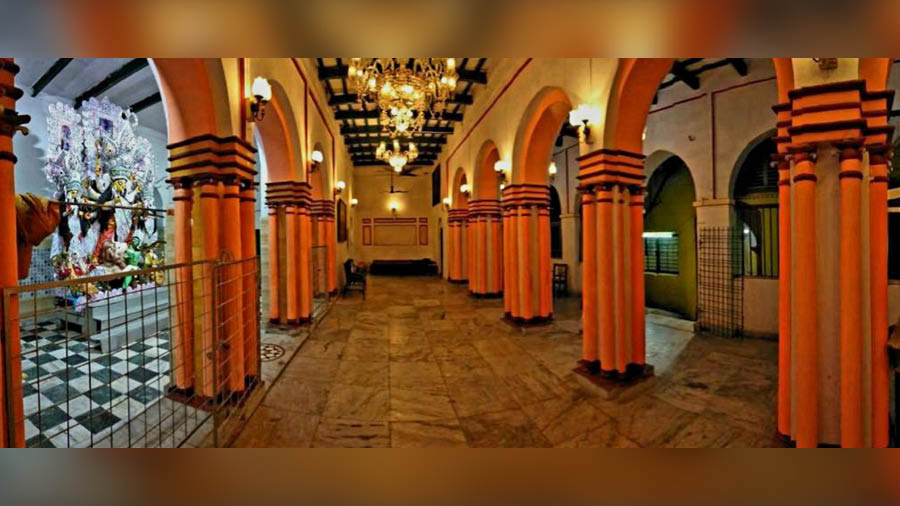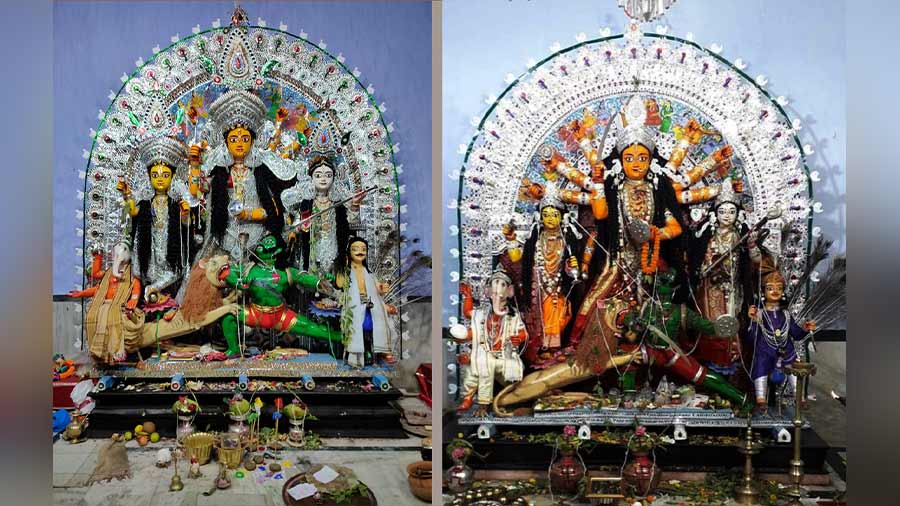The Durga puja at the Dutta Chaudhuri family home in Andul stands apart simply because it is one of the oldest family-run Durga pujas started from the late 16th century. The puja was initiated by the family’s 17th descendant, zamindar Ramsharan Dutta (1548 - 1606), who was the sixth collector of Muzaffarpur Pargana, with the title ‘Chaudhuri’, under Saptagram Sarkar of Subah Bangla.
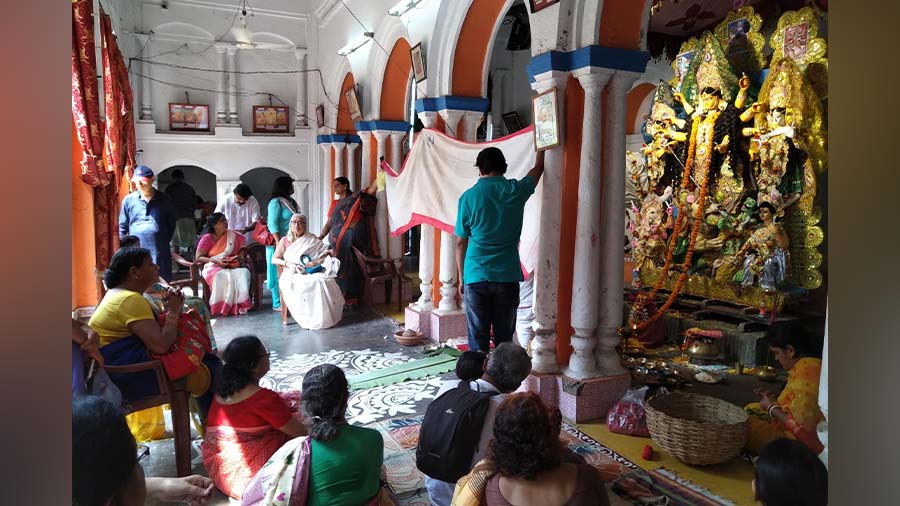
Durga Puja at the thakur dalan of Andul Dutta Chaudhuri family Amitabha Gupta
There is a legendary story debated by many historians that five Kshatriya clans came to Bengal along with five Brahmin clans from Kanyakubj or Kanauj during the rule of the Sen dynasty in the 11th century. The family history of Dutta Chaudhuris claims that Purushottam Datta was the eldest of the five Kshatriya clans who started living in the village of Bally, presently in Howrah district of West Bengal. Eventually his descendants Kanai (Kanu) Dutta and his eighth son Murari Dutta were faithful treasurers in the court of Sikandar Shah and acquired the title ‘Biswas’.
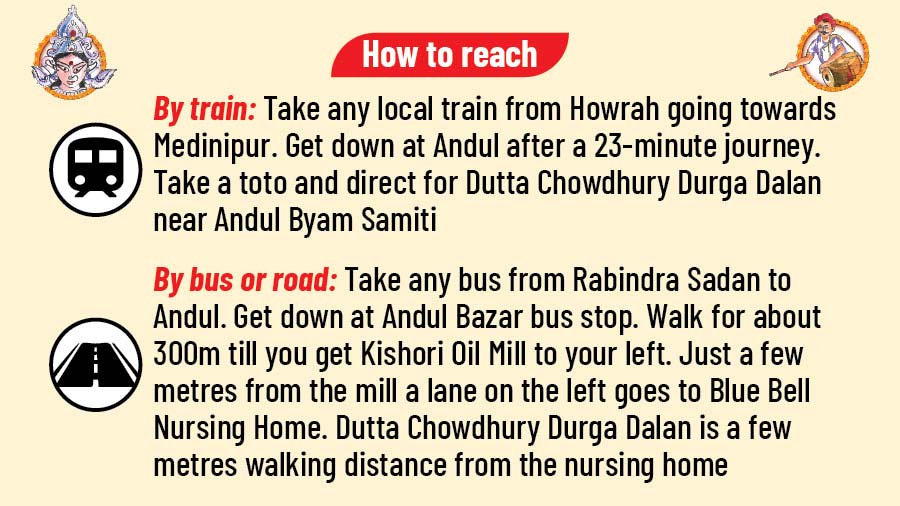
Murari Dutta’s son, Tekari Datta, migrated from Bally to a new township which was later named Andul. He amassed enough wealth and property (covering the major portion of the pargana) and so he gradually became zamindar by himself. Sikandar Shah designated him as a pargana collector with the title ‘Chaudhuri’. Since then, the family acquired the surname of Dutta Chaudhuri.
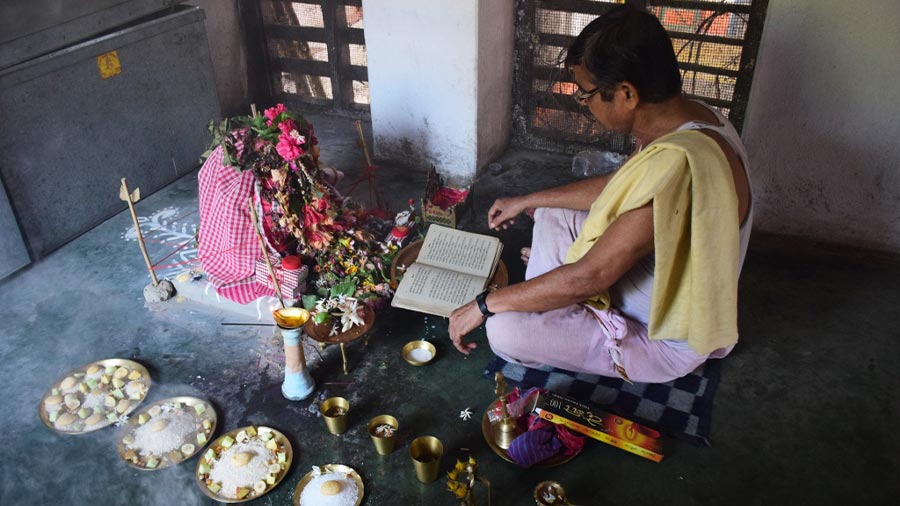
‘Bodhon’ of the goddess of Andul Dutta Chaudhuri family takes place on Krishna Nabami ‘tithi’ Amitabha Gupta
In later years, the Andul Dutta Chaudhuri family broke up because of internal feud among three brothers. The families of Ramsharan, Gobindasharan and Harisharan Dutta Chaudhuri decided to separate. The younger brothers moved out, while Ramsharan Dutta Chaudhuri stayed back in the house at Andul. ‘‘
During the later part of the 16th century, Andul was a mouza under Muzaffarpur Pargana. Ramsharan Dutta had a palatial house as well as a kutchery house. He had initially started Durga puja in a simple manner, inside a hay-brick Aatchala on the bank of the Saraswati river in Andul. His second wife’s son, Kasishwar Datta Choudhury, built a permanent Durga dalan, which later collapsed in 1923. The present Durga dalan was built after that.
The Dutta Chaudhuri family addresses Devi Durga as Sri Sri Rajarajeshwari Thakurani Mata as she is considered to be the sister of Sri Sri Rajarajeshwar Narayan (popularly ‘narayan of the Chaudhuris’), one of the family deities of the Datta Chaudhuris.
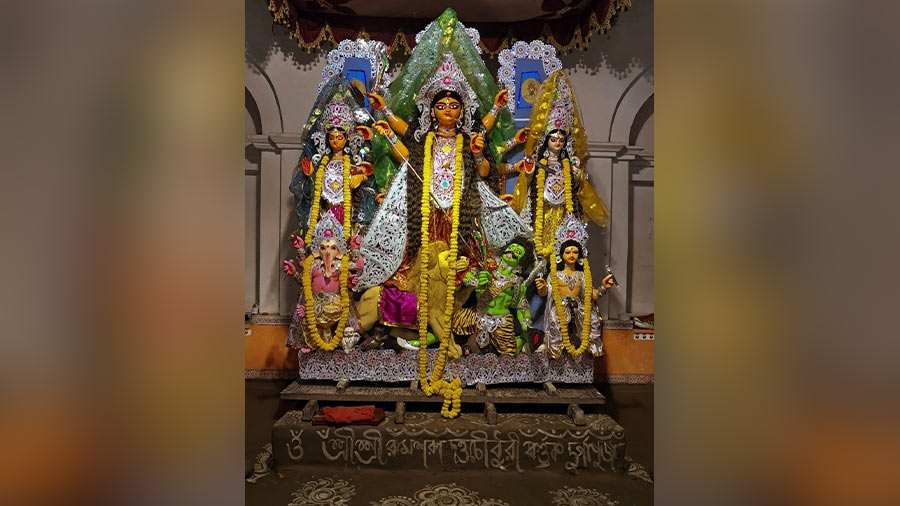
The Andul Dutta Chaudhuri family addresses Devi Durga as Sri Sri Rajarajeshwari Thakurani Mata Andul Dutta Chaudhuri family archives
Earlier, the kathamo puja was conducted on the day of Ulto Rath, but nowadays the ritual is observed on the day of Janmashtami. The chalachitra of the goddess is tanachauri-styled, which means there are three chalas or backdrops instead of one, each having a flat base. The chala of goddess Saraswati has the image of Dakshina-Kali painted on it, goddess Laksmi has Jagaddhatri and finally, goddess Durga has Vishnu in Ananta Shayan posture. Earlier, there was a practice of putting small figurines of Jaya, Bijaya and Mahadev on top of the chalas of Saraswati, Lakshmi and Durga respectively but this was discontinued after the 1990s.
Durga puja in this family is conducted as per Brihat Nandikeshwar Puran. Bodhon or the ritual of awakening the goddess is conducted on Krishna Navami Tithi or 12 days before the beginning of Durga Puja.

A photo of Durga Puja of the Andul Dutta Chaudhuri family from the 1990s Andul Dutta Chaudhuri family archives
Nabapatrika rituals or kola bou snan takes place in a nearby pond. Bhog or food offerings to the goddess on Saptami and Ashtami are khichuri, five types of fried vegetables, payesh (creamy rice pudding), chutney (thick sweet vegetable and fruit sauce) and several type of sweets like jibe goja similar to that of Puri at Odisha, chandrapuli, manohara, narkel naru, chhancher sandesh and finally, the trademark sweet of the Dutta Chaudhuris — agamonda. Agamonda is made of coconut, mewa and kheer and is ultimately decorated with pistachio, almonds and raisins. On Navami, the menu is the same except for the fact that pulao is added with khichuri.

Nabapatrika proccession of the Andul Dutta Chaudhuri family Andul Dutta Chaudhuri family archives
Following the old custom, there is still a policy of saying ‘Baba, Ramsharan’s kadai dhar’ while distributing prasad among the housemates. Behind this strange custom lie old bitter memories. In the past, this family had become destitute due to a dispute among family members. The phrase is still said so that Ramsharan’s family will never be in trouble. Among other rituals, an interesting one is followed during the entire Devipaksha, unmarried women of the house must wear conch bangles or shankha. Of course, they can’t wear metal or iron. This custom is prevalent because the goddess is seen here as a daughter of the house. The goddess is draped in a green veil on Sasthi which remains till Navami. On Dashami, a red veil is provided instead of the green one.
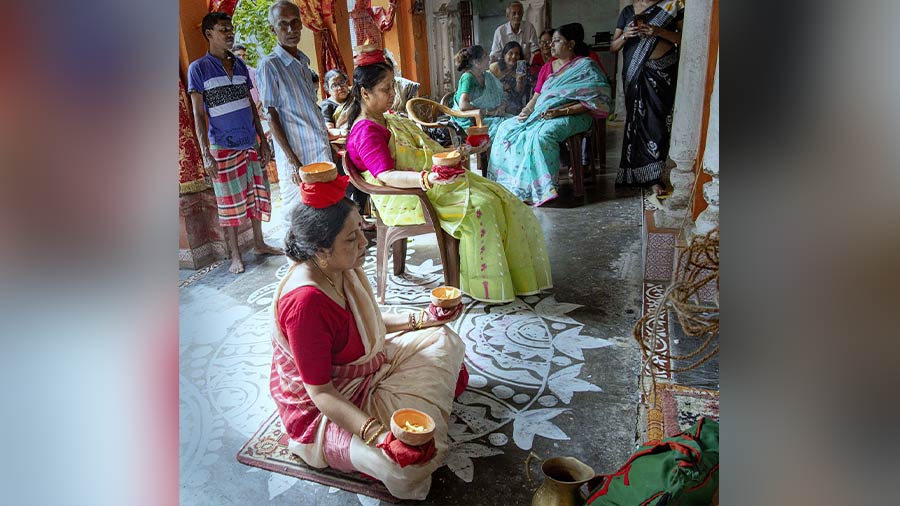
‘Dhuno purano’ rituals at Andul Dutta Chaudhuri family Durga Puja Andul Dutta Chaudhuri family archives
On the morning of Navami, the priest performs arati with a black earthen lamp in front of the idol. A total of 28 lamps are turned upside down after arati and extinguished. This is called the kalo pradip arati and is done to thwart off the evil black shadow from the family. Kumari Puja and dhuno purano rituals are also held on Navami. Two Kumaris are worshipped – one a Brahmin and the other a non-Brahmin.
Animal sacrifice does not take place in the Dutta Chaudhuri family. Other than the usual sugarcane and gourd sacrifice, there is a shotru bali (killing the enemy) ritual. Here, a human figure, symbolising shatru, an enemy of the family, is made with powdered rice and painted in different colours and later sacrificed kept within a hollow of a banana tree trunk.
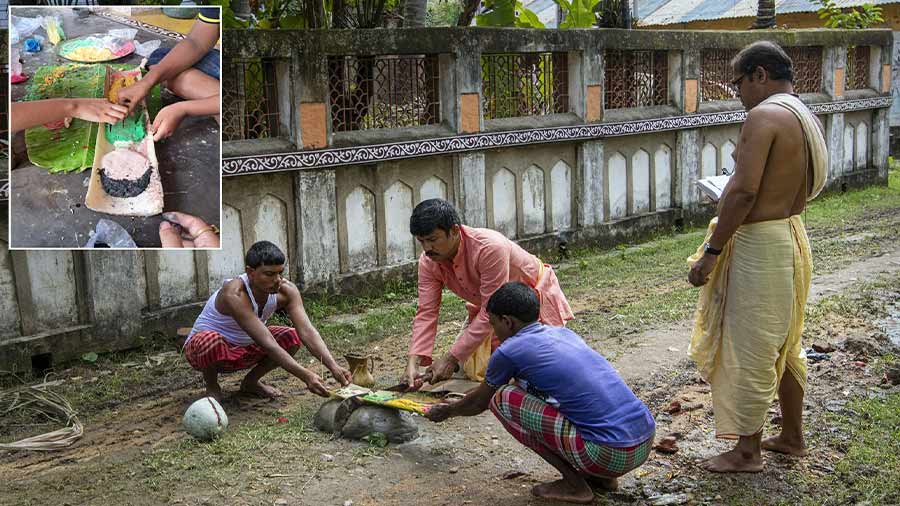
Ritual of ‘Shatru bali’ at Andul Dutta Chaudhuri Durga Puja and (inset) human figure made with powdered rice with different colors representing enemy or ‘shatru’ Andul Dutta Chaudhuri family archives
On Dashami, after the ‘thakur baran’ rituals are conducted by the womenfolk of the family, the deity is taken to Dule Para before immersion. Once the residents of this area were the most loyal subjects of the Dutta Chaudhuri family.
Earlier, the family had their own ghat by the river Saraswati (Chaudhuri Ghat) but now the immersion takes place in an adjacent waterbody.
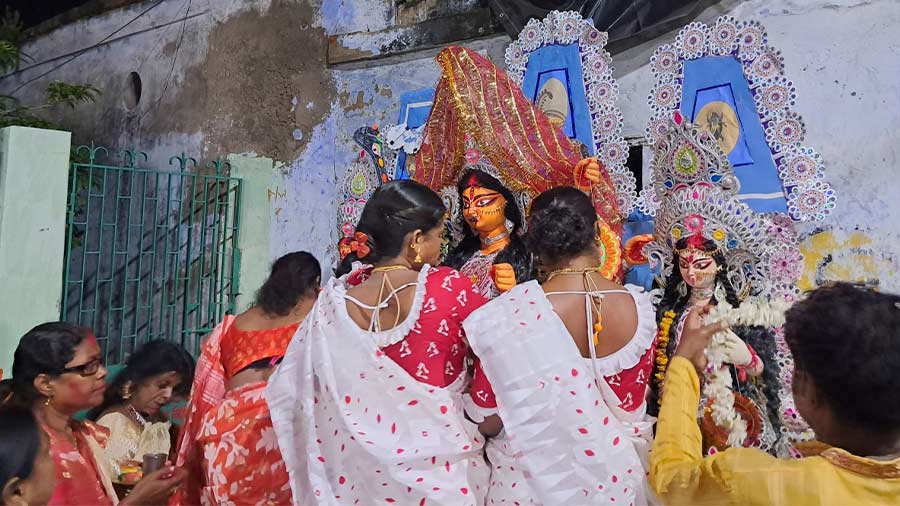
‘Devi boron’ on Dashami by womenfolk from Dule Para who were once subjects of Andul Dutta Chaudhuri family Andul Dutta Chaudhuri family archives
